News
Nitric oxide regulates lignification and carotenoid biosynthesis in postharvest carrots
The application of sodium nitroprusside preserves the appearance and quality of postharvest carrots
Carrots (Daucus carota L., Apiaceae family) are widely cultivated worldwide. Their roots are rich in carotenoids, vitamins, and dietary fiber, and provide a good source of minerals and antioxidants. These phytonutrients play a crucial role in preventing various diseases such as cardiovascular diseases, retinal diseases, night blindness, cataracts, and Alzheimer's disease.
In recent years, there has been a growing demand for fresh and natural products. However, postharvest carrots are prone to color loss, nutrient content reduction, flavor deterioration, and lignification caused by senescence.
Excessive lignin accumulation, an undesirable phenomenon
Lignin biosynthesis is closely related to the normal development of the main root, the important product organ of this vegetable.
As a fundamental component of plant cell walls, lignin provides plant tissues with certain mechanical resistance and hardness, enhances resistance to pathogenic microorganisms, and protects against abiotic stress.
However, excessive lignin accumulation affects the taste and reduces the commercial value of postharvest carrots.
Additionally, during cell senescence, the accumulation of reactive oxygen species (ROS) occurs, along with changes in color due to the oxidative degradation of carotenoids, directly influencing their commercial value.
Effects of nitric oxide
Both endogenous and exogenous nitric oxide (NO) plays a role in regulating carotenoid metabolism and are crucial in delaying the lignification process.
A recent study explored the impact of NO on the lignification process and carotenoid synthesis in postharvest carrots stored at room temperature.
Analyses revealed that treatment with 1.5 mM (millimolar) sodium nitroprusside, an exogenous NO provider that increases nitrate reductase enzyme activity, leads to an increase in total carotenoid levels (α-carotenes and β-carotenoids) and suppresses the expression of lignin biosynthesis genes, resulting in reduced cellular lignification. Additionally, it inhibits ROS generation.
Source
Sun, M.; Yang, T.; Qiao, X.; Zhao, P.; Zhu, Z. P.; Wang, G. L.; Xu, L. L.; Xiong, A. S. (2024). Nitric oxide regulates the lignification and carotenoid biosynthesis of postharvest carrots (Daucus carota L.). Postharvest Biology and Technology, 207:112593.
Image
https://www.antojoentucocina.com/receta/recetas-zanahoria Accessed on 12/26/2023.













